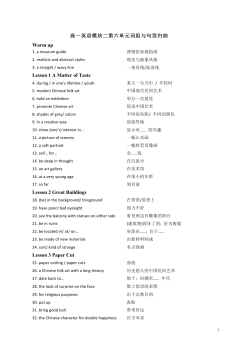
Paper for Chinese Brush Painting The invention of paper made it
Paper for Chinese Brush Painting The invention of paper made it possible to develop brush painting as paper was more absorbent and cheaper than silk. This allowed artists to develop a freer style of painting, culminating in the large, free brush style painting of the Southern Song The paper most commonly used today is called xuan zhi (xiuan or shuen). The name comes from the Xuancheng district in Anhui Province – original papermaking centre of China. These hand made papers are now produced all over China. Often known in the West as “rice paper”, the main ingredient is the inner bark of a species of sandalwood tree. Other fibres such as bamboo or rice straw are mixed with the bark giving different qualities. The recipe of each brand is a trade secret! Today many other papers are also available. All Chinese papers have smooth and rougher sides. This is due to being brushed during the drying process. The most common full sheet size is 54" by 27". Longer sheets are available but the cost goes up steeply due to the difficulty of manufacturing. Some such as bark paper are machine made in long continuous rolls. Paper also comes in a number of thicknesses and in one, two or more ply (layers). Less absorbent papers are made using a coating such as alum, rice or soya bean water, or a mixture of alum and glue. Paper should be rolled up in the air, wrapped in newsprint to keep bugs at bay. Examples Unsized xuan paper - thin, highly absorbent paper which reacts dramatically to the brush and water. Once a mark has been made it cannot be changed. Xuan is most often used for free-style xieyi (hsieh-i) paintings of flowers, birds, animals, landscapes or vegetables. If it has a cloudy appearance and rustles it is good quality. Double xuan paper - stronger paper made from two sheets dried one on top of the other. It is less absorbent and reactive to the brush than single ply. Sometimes used for landscape painting because it is more resilient and offers greater control. Grass paper - inexpensive paper - sold in 4ft sheets and packs of 18” x 12” sheets. It behaves like a moderately sized paper. It can be used as a practice paper but you will need to adjust your technique when you move to Xuan. Mao bian or bamboo paper - wonderful paper for calligraphy and painting. Pi zhi or bark paper - strong, very absorbent paper. Used for landscape, figure and animal painting. It can also be used for mounting paintings. Semi-sized xuan - paper that has been sized with rice water - less absorbent. It can be used for free-style, semi-meticulous painting and calligraphy but it is less reactive to brushwork. Moon Palace paper - Japanese machine made - highly bleached white paper in a continuous roll. It is very smooth on one side and rough on the other and behaves like a semi-sized paper. It is often used as a practice paper but you will need to adjust your technique when you move to Xuan. Sized xuan paper - standard xuan that has been sized with an alum and glue mixture. It is used for gongbi (kung pi - meticulous) painting. This style uses similar techniques to silk painting, requiring very controlled brushwork and a highly un-absorbent surface to allow you to move paint around. It can be thin, very fine (more transparent than silk) and can be treated likewise, or thick and more opaque. Pong or linen paper - strong highly textured, sized paper - often used for lingnan painting or free style calligraphy. © 2015 Marion Dearlove
© Copyright 2025










